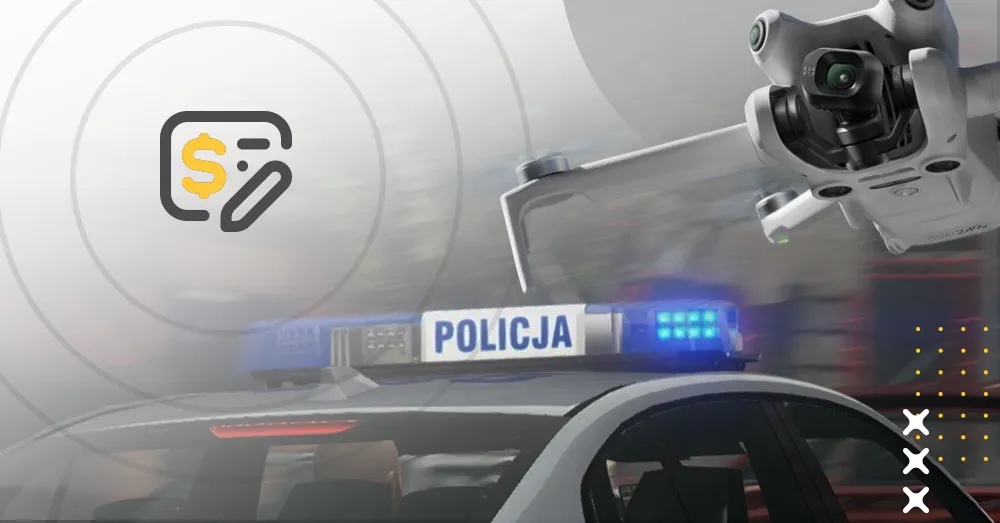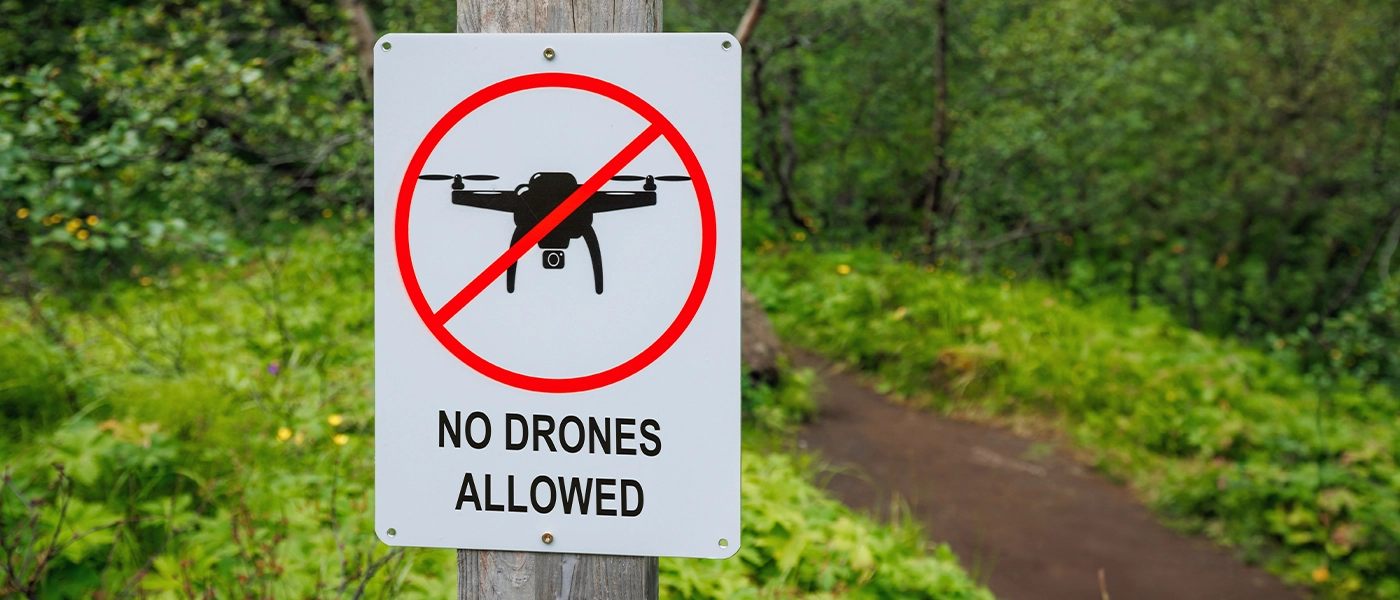Fine for flying a drone - how much are the fines?

Flying a drone is an activity that comes with many requirements. They concern both having the appropriate license and flying in certain conditions and locations. Failure to comply risks serious penalties - from fines even to confiscation of equipment. What to remember to fly legally?
When you can get a fine for flying a drone?
One of the most important issues regarding drone flights is the the requirement to have an appropriate license. The pilot must have the appropriate certificate, in accordance with the parameters of the device and the rules of performing a specific flight. Some devices are exempt from this requirement - however, this only applies to drones under 250g that are not equipped with a camera, that is, primarily equipment that falls into the category of toys. If the flight is made with a drone with a camera (regardless of weight) or with a weight of more than 250 g, registration in the KSID system is required. Detailed information on ratings and flight categories, as well as training materials, can be found at drones.gov.en.
However, the license itself is not everything. In addition, it is also important to compliance with flight safety rules, which include m.in. choosing the right place to fly. The entire route must take place outside of areas off-limits to drones (such as the vicinity of airports), and at a certain distance from third parties and buildings. Ignoring the rules involves not only the risk of various dangerous situations, but also the possibility of receiving a fine. Importantly, a fine for improper drone flying can be issued by both the police and municipal police, as well as border guards. Another potential reason to receive a fine when flying a drone is violating the privacy of others, such as when flying over private property - in certain situations, such actions may be treated as an offence.
New regulations and penalties - what has changed?
The President of the Republic of Poland has signed an amendment to the Aviation Law and certain other laws, which after years of legislative work has become law. This means new rules for operators of unmanned aerial vehicles (BSPs), including more severe penalties for violations. What this means in practice for drone users?
The main purpose of the changes is to increase safety in the airspace and sorting out the rules drone use. Here are the key changes in penalties:
When the drone pilot is responsible:
| Category of operations | The provision that was violated | How much is the penalty in PLN |
| Special | Violation of the conditions of the permit issued to the modeling club/association | 250 |
| Special | Failure to meet the competency requirements expected of BSP pilots operating within modeling clubs and associations | 500 |
| - | Exceeding the manufacturer's recommendations and operating limitations for a given BSP model | 1 000 |
| Special | Violation of STS standard scenario conditions | 3 000 |
| Special | Violation of the terms of the NSTS national standard scenario | 4 000 |
In a situation where the drone operator is responsible:
| Category of operations | The provision that was violated | How much is the penalty in PLN |
| - | No marking of BSP with operator number | 300 |
| - | Failed to inform the office on time of a change in his data in the register | 500 |
| Open | Violation of open category conditions | 4,000 / each violation |
| Special | Violation of the conditions of the standard scenario | 4,000 / each violation |
| Special | No valid operating permit | 10 000 |
| Special | BSP does not meet the technical characteristics prescribed for the operation | 10 000 |
| Special | No remote identification system in the BSP | 10 000 |
| Special | Violation of the requirements of a cross-border operation | 10 000 |
| - | No registration in the ULC system | 10 000 |
| - | Violation of the requirement to register with the ULC system | 10 000 |
| Special | Violation of the terms of the LUC certificate | 12 000 |
| Certified | Violation of the operational requirements of Regulations 923/2012, 965/2012 and 1332/2011 | 15 000 |
| - | Violation of the registration requirement of a BSP subject to certification | 15 000 |
In addition, a provision was indicated that did not specify whether the operator or the pilot was responsible:
| Category of operations | The provision that was violated | How much is the penalty in PLN |
| - | Violation of geographic zone conditions | 10,000 / each violation |
While the rules of drone use are extremely important, a fundamental problem should not be overlooked: awareness of regulations among many drone operators is still low. Meanwhile, such high penalties, especially for minor offenses, will be strongly remembered.
Education instead of punishment
As Megadron, we take the position that education is a much more effective tool than imposing restrictive fines. Mandatory registrations for drone purchases, accessible awareness campaigns or better structured training could minimize the number of violations. In the current situation, many users are unaware of the rules that apply to them, which means that instead of order, we may experience an increase in the number of unaware offenses.
What you can do right now?
If you're a drone pilot, be sure to follow current regulations. Make sure your drone is properly marked, and you yourself are aware of the rules that apply during the flight. At the same time, follow information about changes in the law and join the discussion on the proposed regulations.
Remember that flying a drone is not only fun, but also a responsibility. That is why it is so important that changes in the law promote both safety and the development of this passion in a way that is accessible to all.
How much is the fine for flying a drone in a national park?

A fine for flying a drone can also be issued if the flight takes place in a national park. The following apply here aviation legislation, specifically, the points relating to the protection of the areas of national parks and nature reserves. However, it is worth noting that it is punishable to fly only below the indicated heights of relative, determined by air traffic services. What the penalty for flying a drone in a national park looks like? The consequences can be quite serious - a fine can be as high as PLN 10,000. For this reason, while in the vicinity of national parks, it is advisable to carefully review local regulations and recommendations of the air service before flying. Significantly, some national parks in Poland are located in border areas (e.g., Bieszczady National Park, Bialowieza National Park), which also means the need to comply with regulations related to border protection.
In addition, attention should be paid to species protection regulations. The noise generated by the drone's engines, like the mere presence of such an object in the air, can frighten birds. Therefore, it is recommended to avoid flying over areas that may provide habitat for protected bird species, especially during the breeding season, i.e., the months of March through October. Violations of species protection regulations carry financial penalties, which are considered separately for specific applications, as well as with the possibility of receiving a jail sentence.
Penalty for flying a drone without a license - up to a £15,000 fine
Flying a drone without a license or in unauthorized areas means violation of airspace, which carries severe financial penalties. The amount of the fine depends on the details of the specific situation - the fines range from PLN 250 to even PLN 15,000, and in extreme cases, the service may even impose imprisonment or restriction of freedom. Importantly, just having a license is not enough: in addition, the drone must be marked in a conspicuous place with a sticker with the operator's identifier. Instead, before the flight, it is worth using special applications and portals, such as PANSA, to find out if starting in a particular place is allowed.
Penalties for flying a drone: from fines to confiscation of equipment to imprisonment

Fines for flying a drone can vary widely and depend largely on the specific case. The most severe consequences involve situations where bystanders have been harmed as a result of unlawful drone flight. If, for example, there is a collision between a drone and a passerby, resulting in injuries, the operator could be punished by restriction or imprisonment. Such situations are classified as air traffic disasters, with serious consequences for the perpetrator.
Between fines and jail terms, there is also confiscation of the drone. This is especially used when there has been a the privacy of third parties has been violated - For example, during an unauthorized flight over private property, during which the image of another person was recorded.
How to fly a drone in compliance with regulations and avoid penalties?
As you can see, penalties for flying without authority or in violation of regulations can be very severe. For this reason, it is worth ensuring that the use of a drone is carried out under rules adapted to Polish regulations describing movement in the airspace. The basic issue is acquiring adequate knowledge.
It is worth remembering that registration and the appropriate license are required for most flights. As of 2024, the National Drone Information System (KSID), which brings together key information for operators in one place, is responsible for serving the area. Before flying, on the other hand, it is worth use apps that display information about the restrictions that apply in a given area. The most popular solution of this type is DroneMap. In addition, it is important to adhere to the rules of air traffic safety - Above all, fly at an appropriate distance from third parties and buildings to reduce the risk of collisions and other dangerous situations.
